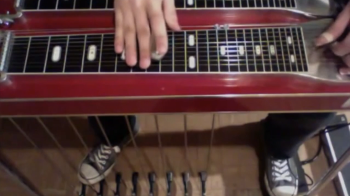

OK, to tune a raise, depress the pedal to be tuned (pedals 'A' and 'B' for pedal 'A'.) then tune the raise at the tuning key (Don't worry about the fact that you just tuned that string to open pitch. The bottom row (closest to the floor) are for raises, and the top row are for lowers.

So, I tune pedal 'A' and pedal 'B' with both pedals depressed, and pedal 'C' with both pedals 'B' and 'C' depressed.** Now, to tune the greatest raises on the changer endplate there are two rows of holes. The reason is, a lot of the time you'll be using both pedals simultaneously, and that will create more cabinet drop than just one pedal (cabinet drop is a form of mechanical pitch drop caused by the depressing of pedals). **Hint: When I tune pedal 'A' I always depress pedal 'B', too. To do this, you'll activate the pedal (or knee lever) for the specific change you wish to tune. The second step will be to tune your changer starting with all your greatest raises (I start with pedals 'A', 'B', 'C', etc.). Also, changing brands of strings may require minor tuning adjustments.ġ) The First Procedure: If you only need to tune the strings to open pitch (most of the time), the guitar is tuned just like all others at the tuning keys.Ģ) The Second Procedure (tuning the changer, or strings and changer with the greatest pitch change) is as follows: First, tune all of the strings to open pitch at the tuning keys (this will give you the starting point by which you'll tune the changer).

For example, if you change the gauge of any string, you WILL have to tune the changer for that string and possibly others. More infrequently, you may have to tune the changer using the other two procedures. NOTE: Most of the time, with a properly adjusted push/pull, tuning at the key head is all you'll need to do. It'll come in handy for "bandstand" tuning adjustments. You might want to keep a tuning chart in your pak-a-seat that indicates which adjustments are at the endplate and at the undercarriage. All other, lesser raises and lowers are tuned by the third or 'undercarriage' tuning. This is important because only the single greatest raise or lower per string will be tuned using the second or 'endplate' tuning procedure. Then check which strings have more than one raise or more than one lower. To start tuning, note which strings have pitch changes (both raises and lowers). To make it less confusing let me just say there are three procedures: Open tuning at the key head, endplate tuning, and undercarriage tuning. Sometimes p/p players get confused by the tuning. Please note: This is only a tuning guide, not a tutorial for setting up a push/pull. With the OK from b0b and the 'Forum' at large, I respectfully request that this thread be made as a "sticky" for quick reference. On several occasions, in the past, I've posted a method. From time to time, a member of the 'Forum' will post asking how to tune an Emmons 'push/pull' guitar.


 0 kommentar(er)
0 kommentar(er)
